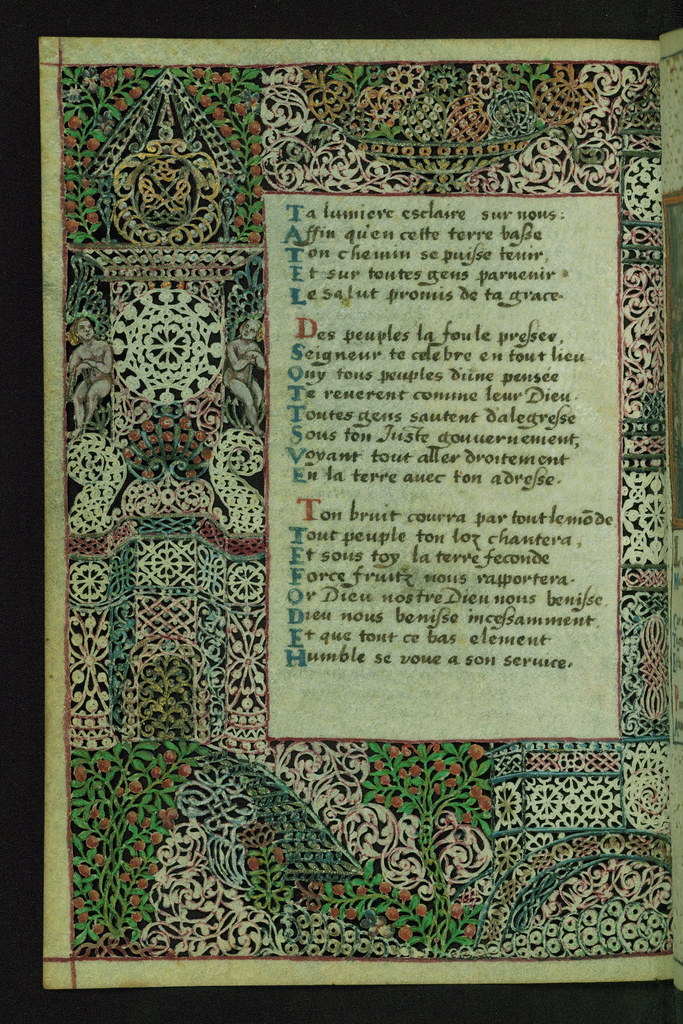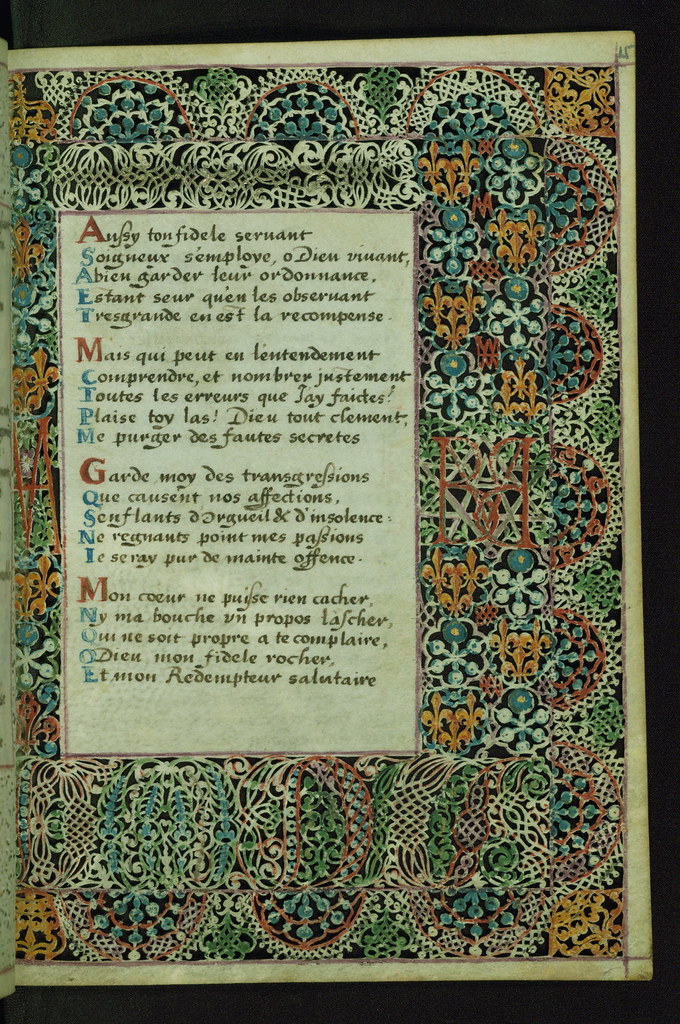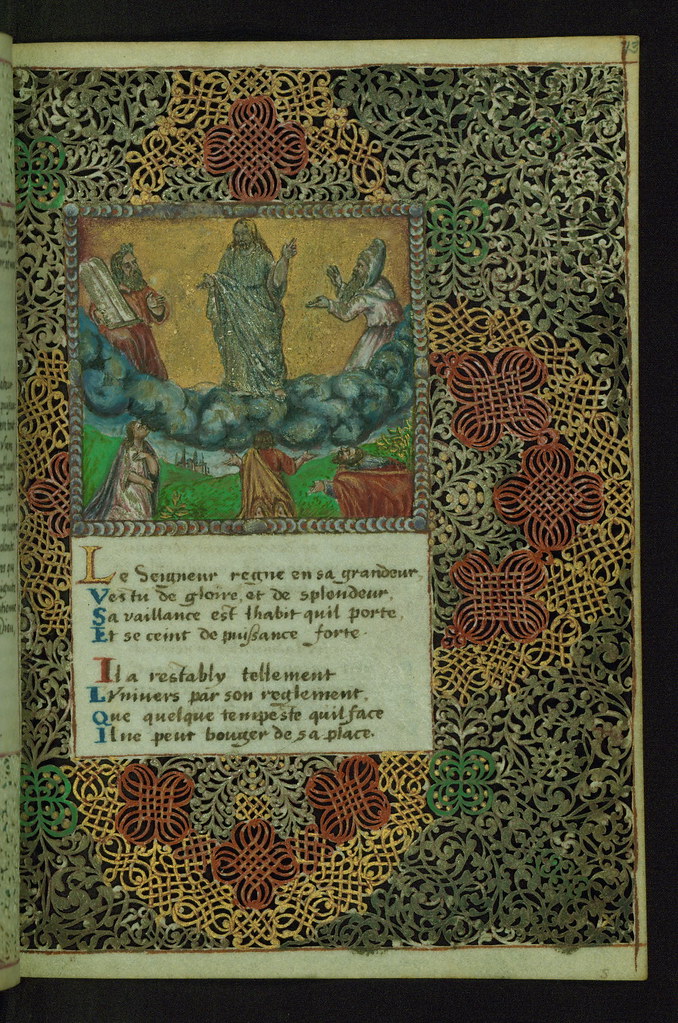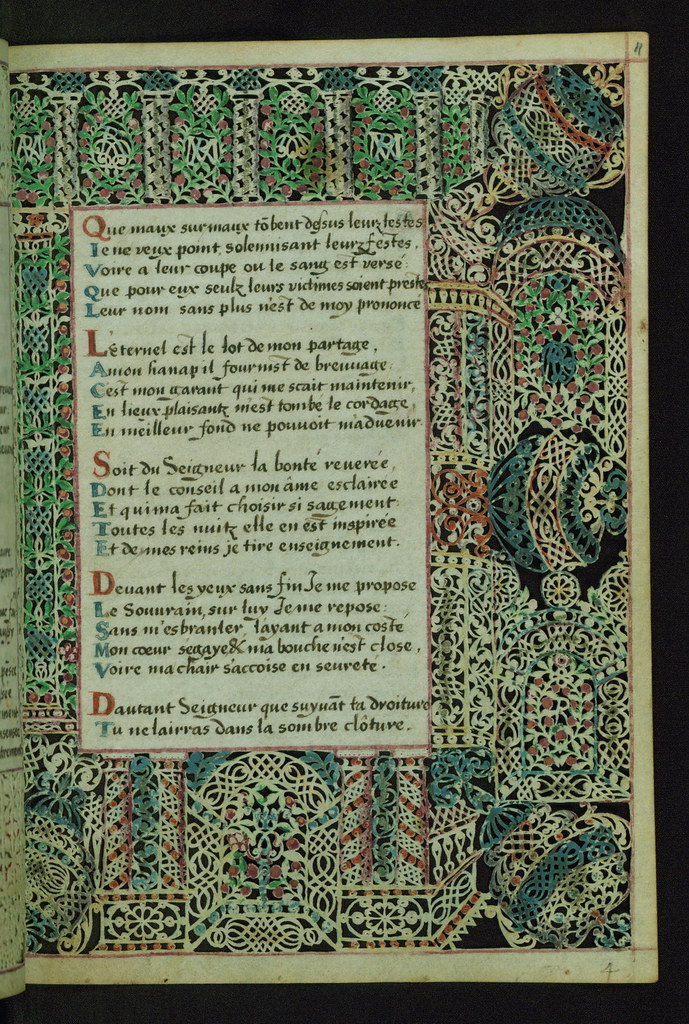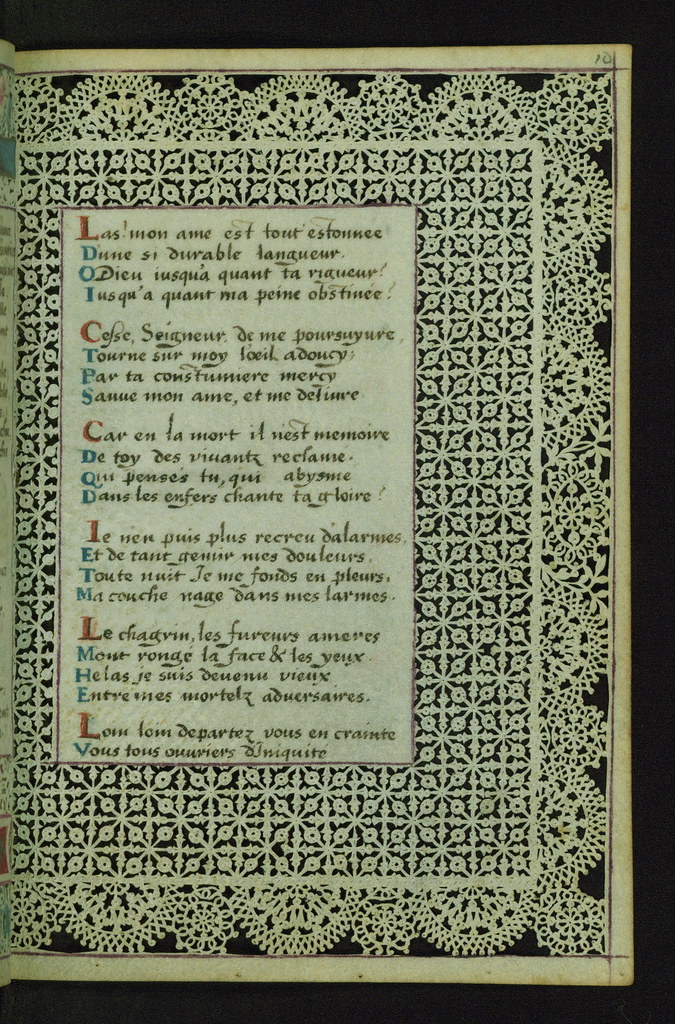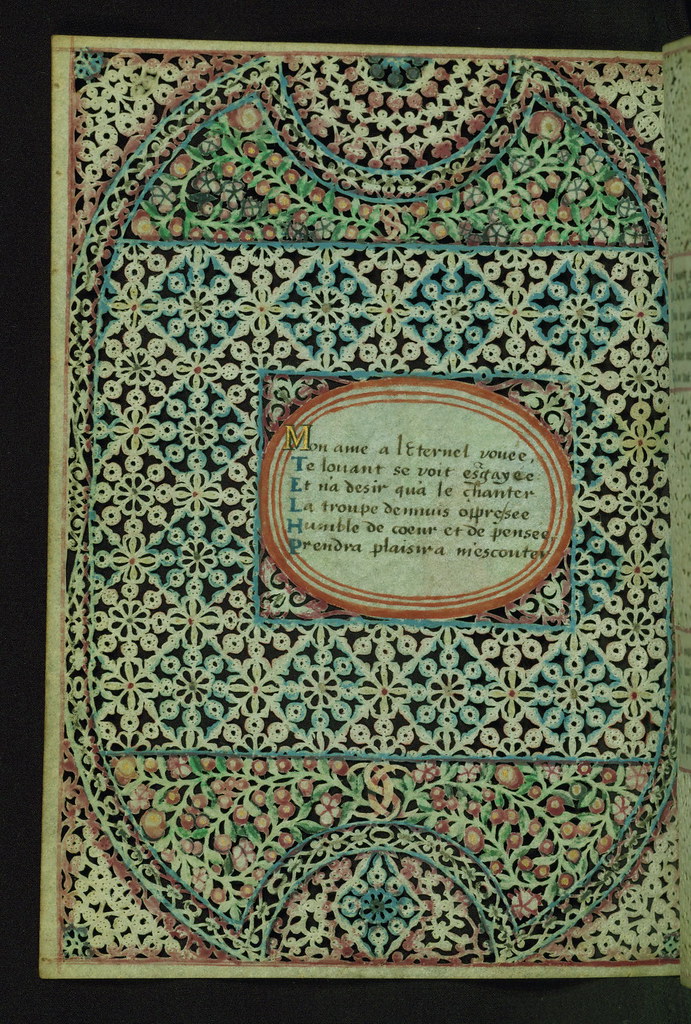A metaphoric journey that, through manuscripts, will take us to different centuries, cultures, places and themes. This blog is curated by Rromir Imami - Digital Media and Communications professional for Cultural Heritage with passion to bring...
Don't wanna be here? Send us removal request.
Photo
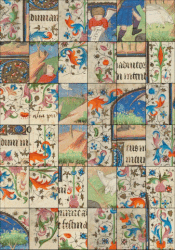
A small puzzle solving challenge :) To give it a try, please visit this link: http://blalbrit.github.io/2016-05-25-slide_puzzle.html
Image source: Chavannes-près-Renens, Archives cantonales vaudoises, P Château de La Sarraz H 50, f. 240v – Book of Hours of Jean de Gingins (http://www.e-codices.unifr.ch/en/acv/P-Sarraz-H-0050/240v)(via GIPHY)
58 notes
·
View notes
Video
Lace Book of Marie de' Medici, Lace margins, Walters Manuscript W.494, Folio 17v by Walters Art Museum Via Flickr: This Prayerbook was made for Marie de' Medici in the second quarter of the seventeenth century. Beyond its provenance as a personal book owned by the famous queen, it is exceptional for its intricately cut borders, which transform the parchment margins into lace. This effect was created using a technique known as "canivet," in which a small knife was used to cut ornate patterns into paper or parchment. An art form that flourished originally among nuns in France, Germany, and the Netherlands beginning in the sixteenth century, it was employed to exceptional effect in several manuscripts connected with Marie de' Medici. The Walters manuscript, made for her while she was regent of France, and wife of King Henry IV, contains twenty-eight miniatures, including original religious imagery as well as several later additions: a gouache portrait of the elderly queen, and nine small miniatures produced in Bruges ca. 1450 by an artist influenced by the Eyckian and Gold Scrolls styles prevalent at the time; the coat-of-arms of Marie de Medici, as well as her monogram. The Walters manuscript retains its original binding composed of mosaic inlays in green and black leather, as well as fine gilt pointillé foliate tooling, and a replica of the binding was created by Léon Gruel for Henry Walters on one of his seventeenth-century printed books (92.467) that also connects to Marie de' Medici. All manuscript images and descriptions were created and are provided through Preservation and Access grants awarded to the Walters Art Museum by the National Endowment for the Humanities, 2008-2014. Access a complete set of high-resolution archival images of this manuscript for free on the Digital Walters at www.thedigitalwalters.org/Data/WaltersManuscripts/html/W494/
#Prayer book#Flemish#Christian#French#Book#Manuscript#Heraldry#Illumination#Miniature#Notable binding#Original binding#Ornament#Painting#Walters Art Museum#Flanders#France#17th century#15th century#Devotion
73 notes
·
View notes
Video
Lace Book of Marie de' Medici, Lace margins, Walters Manuscript W.494, Folio 15r by Walters Art Museum Via Flickr: This Prayerbook was made for Marie de' Medici in the second quarter of the seventeenth century. Beyond its provenance as a personal book owned by the famous queen, it is exceptional for its intricately cut borders, which transform the parchment margins into lace. This effect was created using a technique known as "canivet," in which a small knife was used to cut ornate patterns into paper or parchment. An art form that flourished originally among nuns in France, Germany, and the Netherlands beginning in the sixteenth century, it was employed to exceptional effect in several manuscripts connected with Marie de' Medici. The Walters manuscript, made for her while she was regent of France, and wife of King Henry IV, contains twenty-eight miniatures, including original religious imagery as well as several later additions: a gouache portrait of the elderly queen, and nine small miniatures produced in Bruges ca. 1450 by an artist influenced by the Eyckian and Gold Scrolls styles prevalent at the time; the coat-of-arms of Marie de Medici, as well as her monogram. The Walters manuscript retains its original binding composed of mosaic inlays in green and black leather, as well as fine gilt pointillé foliate tooling, and a replica of the binding was created by Léon Gruel for Henry Walters on one of his seventeenth-century printed books (92.467) that also connects to Marie de' Medici. All manuscript images and descriptions were created and are provided through Preservation and Access grants awarded to the Walters Art Museum by the National Endowment for the Humanities, 2008-2014. Access a complete set of high-resolution archival images of this manuscript for free on the Digital Walters at www.thedigitalwalters.org/Data/WaltersManuscripts/html/W494/
#Prayer book#Flemish#Christian#French#Book#Manuscript#Heraldry#Illumination#Miniature#Notable binding#Original binding#Ornament#Painting#Walters Art Museum#Flanders#France#17th century#15th century#Devotion
18 notes
·
View notes
Video
Lace Book of Marie de' Medici, Transfiguration, Walters Manuscript W.494, fol. 13r by Walters Art Museum Via Flickr: This Prayerbook was made for Marie de' Medici in the second quarter of the seventeenth century. Beyond its provenance as a personal book owned by the famous queen, it is exceptional for its intricately cut borders, which transform the parchment margins into lace. This effect was created using a technique known as "canivet," in which a small knife was used to cut ornate patterns into paper or parchment. An art form that flourished originally among nuns in France, Germany, and the Netherlands beginning in the sixteenth century, it was employed to exceptional effect in several manuscripts connected with Marie de' Medici. The Walters manuscript, made for her while she was regent of France, and wife of King Henry IV, contains twenty-eight miniatures, including original religious imagery as well as several later additions: a gouache portrait of the elderly queen, and nine small miniatures produced in Bruges ca. 1450 by an artist influenced by the Eyckian and Gold Scrolls styles prevalent at the time; the coat-of-arms of Marie de Medici, as well as her monogram. The Walters manuscript retains its original binding composed of mosaic inlays in green and black leather, as well as fine gilt pointillé foliate tooling, and a replica of the binding was created by Léon Gruel for Henry Walters on one of his seventeenth-century printed books (92.467) that also connects to Marie de' Medici. All manuscript images and descriptions were created and are provided through Preservation and Access grants awarded to the Walters Art Museum by the National Endowment for the Humanities, 2008-2014. Access a complete set of high-resolution archival images of this manuscript for free on the Digital Walters at www.thedigitalwalters.org/Data/WaltersManuscripts/html/W494/
#Prayer book#Flemish#Christian#French#Book#Manuscript#Heraldry#Illumination#Miniature#Notable binding#Original binding#Ornament#Painting#Walters Art Museum#Flanders#France#17th century#15th century#Devotion
20 notes
·
View notes
Video
Lace Book of Marie de' Medici, Lace margins, Walters Manuscript W.494, Folio 11r by Walters Art Museum Via Flickr: This Prayerbook was made for Marie de' Medici in the second quarter of the seventeenth century. Beyond its provenance as a personal book owned by the famous queen, it is exceptional for its intricately cut borders, which transform the parchment margins into lace. This effect was created using a technique known as "canivet," in which a small knife was used to cut ornate patterns into paper or parchment. An art form that flourished originally among nuns in France, Germany, and the Netherlands beginning in the sixteenth century, it was employed to exceptional effect in several manuscripts connected with Marie de' Medici. The Walters manuscript, made for her while she was regent of France, and wife of King Henry IV, contains twenty-eight miniatures, including original religious imagery as well as several later additions: a gouache portrait of the elderly queen, and nine small miniatures produced in Bruges ca. 1450 by an artist influenced by the Eyckian and Gold Scrolls styles prevalent at the time; the coat-of-arms of Marie de Medici, as well as her monogram. The Walters manuscript retains its original binding composed of mosaic inlays in green and black leather, as well as fine gilt pointillé foliate tooling, and a replica of the binding was created by Léon Gruel for Henry Walters on one of his seventeenth-century printed books (92.467) that also connects to Marie de' Medici. All manuscript images and descriptions were created and are provided through Preservation and Access grants awarded to the Walters Art Museum by the National Endowment for the Humanities, 2008-2014. Access a complete set of high-resolution archival images of this manuscript for free on the Digital Walters at www.thedigitalwalters.org/Data/WaltersManuscripts/html/W494/
#Prayer book#Flemish#Christian#French#Book#Manuscript#Heraldry#Illumination#Miniature#Notable binding#Original binding#Ornament#Painting#Walters Art Museum#Flanders#France#17th century#15th century#Devotion
18 notes
·
View notes
Video
Lace Book of Marie de' Medici, Lace margins, Walters Manuscript W.494, Folio 10r by Walters Art Museum Via Flickr: This Prayerbook was made for Marie de' Medici in the second quarter of the seventeenth century. Beyond its provenance as a personal book owned by the famous queen, it is exceptional for its intricately cut borders, which transform the parchment margins into lace. This effect was created using a technique known as "canivet," in which a small knife was used to cut ornate patterns into paper or parchment. An art form that flourished originally among nuns in France, Germany, and the Netherlands beginning in the sixteenth century, it was employed to exceptional effect in several manuscripts connected with Marie de' Medici. The Walters manuscript, made for her while she was regent of France, and wife of King Henry IV, contains twenty-eight miniatures, including original religious imagery as well as several later additions: a gouache portrait of the elderly queen, and nine small miniatures produced in Bruges ca. 1450 by an artist influenced by the Eyckian and Gold Scrolls styles prevalent at the time; the coat-of-arms of Marie de Medici, as well as her monogram. The Walters manuscript retains its original binding composed of mosaic inlays in green and black leather, as well as fine gilt pointillé foliate tooling, and a replica of the binding was created by Léon Gruel for Henry Walters on one of his seventeenth-century printed books (92.467) that also connects to Marie de' Medici. All manuscript images and descriptions were created and are provided through Preservation and Access grants awarded to the Walters Art Museum by the National Endowment for the Humanities, 2008-2014. Access a complete set of high-resolution archival images of this manuscript for free on the Digital Walters at www.thedigitalwalters.org/Data/WaltersManuscripts/html/W494/
#Prayer book#Flemish#Christian#French#Book#Manuscript#Heraldry#Illumination#Miniature#Notable binding#Original binding#Ornament#Painting#Walters Art Museum#Flanders#France#17th century#15th century#Devotion
116 notes
·
View notes
Video
Lace Book of Marie de' Medici, John the Baptist baptizing Christ, Walters Manuscript W.494, fol. 8r by Walters Art Museum Via Flickr: This Prayerbook was made for Marie de' Medici in the second quarter of the seventeenth century. Beyond its provenance as a personal book owned by the famous queen, it is exceptional for its intricately cut borders, which transform the parchment margins into lace. This effect was created using a technique known as "canivet," in which a small knife was used to cut ornate patterns into paper or parchment. An art form that flourished originally among nuns in France, Germany, and the Netherlands beginning in the sixteenth century, it was employed to exceptional effect in several manuscripts connected with Marie de' Medici. The Walters manuscript, made for her while she was regent of France, and wife of King Henry IV, contains twenty-eight miniatures, including original religious imagery as well as several later additions: a gouache portrait of the elderly queen, and nine small miniatures produced in Bruges ca. 1450 by an artist influenced by the Eyckian and Gold Scrolls styles prevalent at the time; the coat-of-arms of Marie de Medici, as well as her monogram. The Walters manuscript retains its original binding composed of mosaic inlays in green and black leather, as well as fine gilt pointillé foliate tooling, and a replica of the binding was created by Léon Gruel for Henry Walters on one of his seventeenth-century printed books (92.467) that also connects to Marie de' Medici. All manuscript images and descriptions were created and are provided through Preservation and Access grants awarded to the Walters Art Museum by the National Endowment for the Humanities, 2008-2014. Access a complete set of high-resolution archival images of this manuscript for free on the Digital Walters at www.thedigitalwalters.org/Data/WaltersManuscripts/html/W494/
#Prayer book#Flemish#Christian#French#Book#Manuscript#Heraldry#Illumination#Miniature#Notable binding#Original binding#Ornament#Painting#Walters Art Museum#Flanders#France#17th century#15th century#Devotion
14 notes
·
View notes
Video
Lace Book of Marie de' Medici, Lace margins, Walters Manuscript W.494, Folio 6v by Walters Art Museum Via Flickr: This Prayerbook was made for Marie de' Medici in the second quarter of the seventeenth century. Beyond its provenance as a personal book owned by the famous queen, it is exceptional for its intricately cut borders, which transform the parchment margins into lace. This effect was created using a technique known as "canivet," in which a small knife was used to cut ornate patterns into paper or parchment. An art form that flourished originally among nuns in France, Germany, and the Netherlands beginning in the sixteenth century, it was employed to exceptional effect in several manuscripts connected with Marie de' Medici. The Walters manuscript, made for her while she was regent of France, and wife of King Henry IV, contains twenty-eight miniatures, including original religious imagery as well as several later additions: a gouache portrait of the elderly queen, and nine small miniatures produced in Bruges ca. 1450 by an artist influenced by the Eyckian and Gold Scrolls styles prevalent at the time; the coat-of-arms of Marie de Medici, as well as her monogram. The Walters manuscript retains its original binding composed of mosaic inlays in green and black leather, as well as fine gilt pointillé foliate tooling, and a replica of the binding was created by Léon Gruel for Henry Walters on one of his seventeenth-century printed books (92.467) that also connects to Marie de' Medici. All manuscript images and descriptions were created and are provided through Preservation and Access grants awarded to the Walters Art Museum by the National Endowment for the Humanities, 2008-2014. Access a complete set of high-resolution archival images of this manuscript for free on the Digital Walters at www.thedigitalwalters.org/Data/WaltersManuscripts/html/W494/
#Prayer book#Flemish#Christian#French#Book#Manuscript#Heraldry#Illumination#Miniature#Notable binding#Original binding#Ornament#Painting#Walters Art Museum#Flanders#France#17th century#15th century#Devotion
18 notes
·
View notes
Video
Lace Book of Marie de' Medici, Flight into Egypt, Walters Manuscript W.494, fol. 6r by Walters Art Museum Via Flickr: This Prayerbook was made for Marie de' Medici in the second quarter of the seventeenth century. Beyond its provenance as a personal book owned by the famous queen, it is exceptional for its intricately cut borders, which transform the parchment margins into lace. This effect was created using a technique known as "canivet," in which a small knife was used to cut ornate patterns into paper or parchment. An art form that flourished originally among nuns in France, Germany, and the Netherlands beginning in the sixteenth century, it was employed to exceptional effect in several manuscripts connected with Marie de' Medici. The Walters manuscript, made for her while she was regent of France, and wife of King Henry IV, contains twenty-eight miniatures, including original religious imagery as well as several later additions: a gouache portrait of the elderly queen, and nine small miniatures produced in Bruges ca. 1450 by an artist influenced by the Eyckian and Gold Scrolls styles prevalent at the time; the coat-of-arms of Marie de Medici, as well as her monogram. The Walters manuscript retains its original binding composed of mosaic inlays in green and black leather, as well as fine gilt pointillé foliate tooling, and a replica of the binding was created by Léon Gruel for Henry Walters on one of his seventeenth-century printed books (92.467) that also connects to Marie de' Medici. All manuscript images and descriptions were created and are provided through Preservation and Access grants awarded to the Walters Art Museum by the National Endowment for the Humanities, 2008-2014. Access a complete set of high-resolution archival images of this manuscript for free on the Digital Walters at www.thedigitalwalters.org/Data/WaltersManuscripts/html/W494/
#Prayer book#Flemish#Christian#French#Book#Manuscript#Heraldry#Illumination#Miniature#Notable binding#Original binding#Ornament#Painting#Walters Art Museum#Flanders#France#17th century#15th century#Devotion
18 notes
·
View notes
Video
Porrentruy, Bibliothèque cantonale jurassienne, Ms. 22, f. 33r by e-codices Via Flickr: Manuscript title: Breviarium basileense; Manuscript summary: This breviary was meant for use in the diocese of Basel. There are still partially visible traces of coats of arms that were painted on ff. 33r, 41r, 129r and 279r and were later erased; these allow the codex to be attributed to Arnold of Rotberg, Bishop of Basel from 1451 to 1458. His successor, Jean de Venningen (1458-1478) noted on f. 5r the repurchase of the manuscript from Porrentruy Castle on June 29th 1461. Origin: Porrentruy, Switzerland; Period: 15th century; Image source: Porrentruy, Bibliothèque cantonale jurassienne, Ms. 22: Breviarium basileense (www.e-codices.unifr.ch/en/list/one/bcj/0022).
25 notes
·
View notes
Video
Porrentruy, Bibliothèque cantonale jurassienne, Ms. 22, f. 44v by e-codices Via Flickr: Manuscript title: Breviarium basileense; Manuscript summary: This breviary was meant for use in the diocese of Basel. There are still partially visible traces of coats of arms that were painted on ff. 33r, 41r, 129r and 279r and were later erased; these allow the codex to be attributed to Arnold of Rotberg, Bishop of Basel from 1451 to 1458. His successor, Jean de Venningen (1458-1478) noted on f. 5r the repurchase of the manuscript from Porrentruy Castle on June 29th 1461. Origin: Porrentruy, Switzerland; Period: 15th century; Image source: Porrentruy, Bibliothèque cantonale jurassienne, Ms. 22: Breviarium basileense (www.e-codices.unifr.ch/en/list/one/bcj/0022).
18 notes
·
View notes
Video
Porrentruy, Bibliothèque cantonale jurassienne, Ms. 22, f. 129r by e-codices Via Flickr: Manuscript title: Breviarium basileense; Manuscript summary: This breviary was meant for use in the diocese of Basel. There are still partially visible traces of coats of arms that were painted on ff. 33r, 41r, 129r and 279r and were later erased; these allow the codex to be attributed to Arnold of Rotberg, Bishop of Basel from 1451 to 1458. His successor, Jean de Venningen (1458-1478) noted on f. 5r the repurchase of the manuscript from Porrentruy Castle on June 29th 1461. Origin: Porrentruy, Switzerland; Period: 15th century; Image source: Porrentruy, Bibliothèque cantonale jurassienne, Ms. 22: Breviarium basileense (www.e-codices.unifr.ch/en/list/one/bcj/0022).
#medieval#e-codices#Switzerland#Manuscript#Library#codex#Swiss#illuminated#mittelalterlich#Schweiz#Handschrift#Bibliothek#Illuminiert#medievale#Manoscritto#Svizzera#Biblioteca#Miniato#médiéval#Manuscrit#Suisse#Bibliothèque#Enluminé#www.e-codices.unifr.ch#15th century#Latin#Porrentruy
42 notes
·
View notes
Video
Porrentruy, Bibliothèque cantonale jurassienne, Ms. 22, f. e011 by e-codices Via Flickr: Manuscript title: Breviarium basileense; Manuscript summary: This breviary was meant for use in the diocese of Basel. There are still partially visible traces of coats of arms that were painted on ff. 33r, 41r, 129r and 279r and were later erased; these allow the codex to be attributed to Arnold of Rotberg, Bishop of Basel from 1451 to 1458. His successor, Jean de Venningen (1458-1478) noted on f. 5r the repurchase of the manuscript from Porrentruy Castle on June 29th 1461. Origin: Porrentruy, Switzerland; Period: 15th century; Image source: Porrentruy, Bibliothèque cantonale jurassienne, Ms. 22: Breviarium basileense (www.e-codices.unifr.ch/en/list/one/bcj/0022).
39 notes
·
View notes
Video
Appenzell, Landesarchiv Appenzell Innerrhoden, E.10.02.01.01, f. 74r by e-codices Via Flickr: Manuscript title: Silver Book of the Land Manuscript summary: On 86 leaves of parchment, the Silver Book of the Land contains the statutes of the entire region of Appenzell. It is an assemblage of older legal texts; at a later time more recent statutes were added to it. Following the division of the region of Appenzell that took place in 1597, the book became the property of the Canton of Appenzell Innerrhoden and remained valid into the 19th century. Rich decorations consisting of miniatures and initials indicate the great importance attributed to this volume. Origin: Appenzell (Switzerland) Period: 16th century Image source: Appenzell, Landesarchiv Appenzell Innerrhoden, E.10.02.01.01: Silver Book of the Land (www.e-codices.unifr.ch/en/list/one/laai/E-10-02-01-01)
29 notes
·
View notes
Link
27 notes
·
View notes
Video
Appenzell, Landesarchiv Appenzell Innerrhoden, E.10.02.01.01, f. 61r by e-codices Via Flickr: Manuscript title: Silver Book of the Land Manuscript summary: On 86 leaves of parchment, the Silver Book of the Land contains the statutes of the entire region of Appenzell. It is an assemblage of older legal texts; at a later time more recent statutes were added to it. Following the division of the region of Appenzell that took place in 1597, the book became the property of the Canton of Appenzell Innerrhoden and remained valid into the 19th century. Rich decorations consisting of miniatures and initials indicate the great importance attributed to this volume. Origin: Appenzell (Switzerland) Period: 16th century Image source: Appenzell, Landesarchiv Appenzell Innerrhoden, E.10.02.01.01: Silver Book of the Land (www.e-codices.unifr.ch/en/list/one/laai/E-10-02-01-01)
21 notes
·
View notes
Video
Appenzell, Landesarchiv Appenzell Innerrhoden, E.10.02.01.01, f. 52r by e-codices Via Flickr: Manuscript title: Silver Book of the Land Manuscript summary: On 86 leaves of parchment, the Silver Book of the Land contains the statutes of the entire region of Appenzell. It is an assemblage of older legal texts; at a later time more recent statutes were added to it. Following the division of the region of Appenzell that took place in 1597, the book became the property of the Canton of Appenzell Innerrhoden and remained valid into the 19th century. Rich decorations consisting of miniatures and initials indicate the great importance attributed to this volume. Origin: Appenzell (Switzerland) Period: 16th century Image source: Appenzell, Landesarchiv Appenzell Innerrhoden, E.10.02.01.01: Silver Book of the Land (www.e-codices.unifr.ch/en/list/one/laai/E-10-02-01-01)
10 notes
·
View notes
